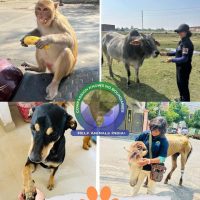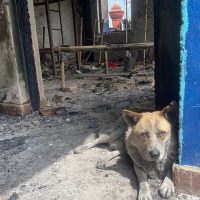Why Vegan? Animal Agriculture in India
Content courtesy of FIAPO (Federation of Indian Animal Protection Organizations).
Animals
Animals are sentient beings, like human beings. They can observe and feel pain and happiness just as humans can. Production of milk for human consumption causes them immense suffering.
The dairy industry has flourished since the white revolution and along with this India has become the leading beef exporter, with the “refuse” of the dairy industry being slaughtered and exported.
To add insult to injury, the dairy industry paints the picture of cows and buffaloes as commodities, solely to be exploited for commercial gains, rather than the gentle, thinking, feeling being that they are.
Contrary to popular belief, animals farming in India is as intensive and cruel as anywhere else in the world.
Following the western world trends, more and more animal farms are being established in India. With the world’s largest dairy herd (cows and buffaloes) at 304 million and the nation ranks first in milk production, with 155 million tonnes of milk produced in 2015-2016, India’s animals are at perilous risk of factory farming cruelties.
DAIRY
India is full of people who do not want to harm animals and have thus adopted a vegetarian lifestyle. We can play an active role in bringing to light the truth behind the production of dairy and dairy products and just how our health suffers from it for these people.
Here are a few things to ponder over regarding the practices of the dairy industry.
- Animal feed: Are the animals taken out for grazing? If the dairy is in a thriving city, chances are there is no land available for grazing nearby. The cows/buffaloes may be let loose, chewing on plastic waste all day, and being milked morning and evening. This is a great indicator of what milk is really made up of and the lack of food control and availability at dairy farms.
- Number of animals: This number should ideally be followed by how much space is available (or how much space does each animal require) and how many people are there to take care of the cows etc. Usually, animals are kept in intensively confined spaces, often standing in their own dung or urine for hours on end.
- Waste management: Animals are capable of producing a lot of dung! Most farmers have no system of waste management in place and just let it flow along with water, which leads to overflowing drains and unhygienic conditions.
- Non-therapeutic medication: Buffaloes are often given Oxytocin, an illegal hormone which is harmful to the animal as well the consumers of milk the animal is made to produce. This drug causes pains equivalent to labour pains to the animal it is injected to. The drug is given for increasing milk production and to cattle who have trouble lactating if their child is not around.
- Registration of premises: Currently any dairy housing more than 5 animals needs to be registered. But most backyard dairies do not have registrations.
- Length of stay: A cow in healthy happy conditions ordinarily lives for around 26 years, although after being milked and artificially impregnated over and over again, the average age of a dairy cow/buffalo is only 6-8 years.
- What happens to the male calves: Milk is a by-product of birth, an essential support for the calves. In dairy farms, male calves are often starved to death, abandoned or sold for slaughter.
- Hygiene: Unsanitary premises, prevalent in dairy farms, lead to Mastitis, which results in more pus in your milk!
Meat
A highly intelligent species, with both high domestic production and consumption; chickens are one of the most abused species in India.
Chickens are capable of communicating with their children before their birth and vocalizing multiple sounds to care.
Sadly, the current Indian meat scene is a sorry one.
- Over 90% of chickens raised for meat (called Broilers) in India are raised on industrialized factory farms.
- Approximately 180 crore chickens are raised for meat in these factory farm conditions every year. Chicken meat consumption is growing in India at over 15% per year.
- The poultry industry forces chickens to live in huge sheds with tens of thousands of other chickens. A typical facility may house 300,000 birds at a time with 40,000-60,000 birds per shed. Each contracted ‘grower’ may grow several million birds annually for the large companies.
- Chickens live on the ground of the shed on litter (wood shavings, rice hulls etc) mixed with faeces from previous generations.
- Broiler chickens have been selectively bred by animal scientists to grow muscle mass extremely fast. Their muscle growth far outpaces the development of their skeletal system and internal organs- as a result their skeletal and organ systems simply cannot keep up with the unnaturally large muscles.
- Some birds become so lame they are unable to walk to food and water and die of starvation or dehydration.
- Mortality rates of broiler chickens, for example, are up to seven times that of chickens not bred for fast growth.
- Faeces decomposition generates several irritating chemicals, including hydrogen sulphide, methane, and ammonia. The high level of these chemicals lead to a host of painful conditions for the chickens including burns on the skin and in the respiratory system, eye lesions, lung congestion, footpad dermatitis, swelling, and haemorrhage.
- The poultry industry takes the chickens to slaughter when they are only about 6 weeks old. At this time, the birds will weigh about 2kg.
- 1The chickens are roughly picked up by their legs and crammed into cages to be transported to chicken shops and slaughter. Humane handling is impossible because catchers are required to handle 300-500 birds per hour. Many of the birds already have painful conditions and this process exacerbates their pain.
- Often animals are killed within sight of one another, using either Halal method, which involves cutting the animal’s throat and leaving the animal to bleed out or Jhatka, where they are beheaded.
EGGS
The International Egg Commission reveals that almost 100% of commercial egg production in India comes from ‘caged’ factory systems. Approximately 18 crore hens are kept in factory farmed conditions in India.
Common facts about the egg production industry in India.
- 90% of all egg-laying hens used for commercial egg production are raised on factory farms where they are kept in small wire cages called “battery cages.” Five to ten are kept in each cage so that each bird has less space than a single A4 size piece of paper. Approximately 18 crore hens are kept in these conditions in India.
- Hens reared in factory farms cannot engage in natural behaviour such as nesting, dust bathing, preening, stretching, wing flapping, perching and roosting, scratching and foraging and exploring.
- Chickens destined for the egg industry are artificially incubated and hatched by the thousands at commercial hatcheries. They never see their mothers.
- Useless to the egg industry, male chicks are customarily killed upon hatching using an electrified kill plate or a purpose-built macerator, in which they are ground up while alive. Crores of male chicks are killed in this manner every year.
- A common practice at poultry farms is that of ‘forced moulting’, wherein all feed is withheld for about 12 days and water for about 1-2 days. This procedure causes birds to ‘moult’, which makes them ready to lay more eggs. This extremely stressful procedure makes hens highly susceptible to Salmonella infection which poses a serious health risk to end consumers.
- Another inhumane practice is that of ‘beak trimming’, where the sensitive, nerve-filled end of each bird’s beak is seared off with a hot blade when she is a young chick. No painkillers are given for this procedure.
FISH
Overfishing has depleted fish populations all over the world. Up to 90% of the big fish (those commonly consumed by humans) in the oceans have already disappeared. Armed with advanced sonar and trawling nets, fishing vessels prowl the oceans, and if this goes on, all stocks of sea fish will collapse by 2048.
Now, to meet the human needs, fish farms are growing at an alarming rate. In 1970s only 5% of the fish we ate were grown in farms. Now, it is 50%. In India, intensive fish farms stock and breed carps, tilapia, catfish, bhetki and different prawns. The fish are stocked densely in small tanks or ponds of filthy water, where diseases and mortality are frequent. Moreover, farm raised fish are often fed fish meal from wild-caught (so called non-commercial) fish. This leads to uncontrolled over fishing in the oceans. For example, 35 kg of wild caught fish is needed to raise a Bhetki fish to 1 kg.
Most of the fish farms use lime, bleaching powder, ammonia and urea for treating the water before stocking the fish. Fungicides, pesticides, growth enhancing hormones and nutritional supplements are added liberally. And after the fish harvest, the water is drained off into the nearby canals and water bodies.
DID YOU KNOW?
Fishes are capable of feeling pain, fear and psychological stress. Scientific evidence shows that they are far more intelligent than we thought. They possess social structures and long-term memories and can respond to stimuli like music. Some of them can even use tools. When pulled out from the depths of the ocean, fish undergo excruciating decompression that ruptures their swim bladders and pops out their eyes.
Fish nets not only catch targeted fish, but also trap a lot of non‐target species and fish below the catch size. These creatures, termed as by catch, include turtles, dolphins, sharks, rays and even seabirds. Most of the bycatch are dead by the time the nets are hauled and the poor things are thrown overboard. About 100 million sharks and rays, 300,000 cetaceans (whales and dolphins) and 100,000 seabirds are killed every year as bycatch. The number of smaller fishes, crabs and shrimps are not even estimated.
PIGS
Post globalisation India has seen a rapid rise in consumerism with a fading out of taboos, especially in the urban spheres. And this has influenced people’s food preferences too. Consumption and demand for pig meat is on the rise and pig farms are being promoted both for small scale and large scale farmers. In the present situation, the small scale semi-intensive farms are bad enough in terms of housing, treatment and transport.
Most pigs are confined within concrete housings for their lives and hygienic conditions. Pigs are transported by tieing their four feet together and stacking them like sacks one above the other, sometimes 40 pigs in a small truck. The pigs then face a horrible slaughter where a red hot iron rod is driven through their body. And now, foreign companies are all set to open factory farms for pigs in India.
Factory farming, in the west, involves gross violation of rights of the living animals. This is how pigs are farmed there:
- The sow (mother pig) is confined in a tiny box called a gestation crate or a sow crate.
- Piglets are mutilated (castrated, teeth pulled out, and tail docked) without anaesthesia, painkillers or minimum sympathy.
- Pigs face horrible slaughter methods.
DID YOU KNOW?
Pigs have descended from wild boars found in parts of Europe and Asia. They are omnivorous and feed on both plants and small animals which they find by foraging and digging the forest soil. They have a natural tendency to wallow (take mud baths) in order to cool off or get rid of parasites. But the pigs farmed for our consumption never get a chance to do all these. They are forced to live in utterly unhealthy conditions.
GOATS AND SHEEP
Though most people in India are accustomed to seeing large herds of goat and sheep freely grazing, the animals are actually taken for grazing and then kept in over-crowded and filthy enclosures. Often, nursing mothers or young lambs only a few months old are taken for slaughter in terrifying conditions. And moreover, the government agricultural bodies are promoting farmers to move towards intensive farming. Fuelled by the increase in both consumption and price of goat meat, large goat farms are being set up by entrepreneurs with help from government or non-government agencies. The days are not far that factory farming will be the trend here too. As a result, cruel treatment, transport and slaughter are on the rise.
“Goats are among the main meat‐producing animals in India whose meat (chevon) is one of the choicest meats and has huge domestic demand. Due to its good economic prospects, goat rearing under intensive and semi‐intensive system for commercial production has been gaining momentum for the past couple of years.” – Indian Council of Agricultural Research
Sheep farming for wool is no longer profitable, due to the WTO agreement which has waived the import duty on wool. Indian sheep farmers have now started cross breeding their wool producing breeds with mutton breeds. According to FAO, India ranked seventh in worldwide sheep meat production in 2006-07.
Here are a few facts about goats and sheep:
- The lambs and kids (baby goats) are routinely subjected to mutilations like castration and tail docking without anaesthesia or painkillers.
- During transport, the four legs of the goat/sheep are tied together and the animals are tossed and stacked above one another like sacks of rice.
- Other than killing for meat, thousands of goats are slaughtered in the name of religious sacrifices.
Living in conditions where simple things that we often take for granted - fresh air, sunlight, freedom to move -are denied to millions to satiate human desires.
Read on to see what's terribly wrong with the way we raise animals for food and lifestyle choices.
LIVE FREE FROM CRUELTY TO ANIMALS
Humanity has believed for ages now that animals are ours to use and abuse. As such, conditions under which these animals are kept have deteriorated drastically.
Today, simple activities that we take for granted – freedom to move, to breathe fresh air, to enjoy sunlight -- are denied to millions every day. Animals in farms are often treated as mere units in a production line, to be kept as long as they give ‘profitable output’ in the form of dairy, eggs, meat or leather.
Milk production is part of pregnancy and birth cycle. Cows do not produce milk without being pregnant, and dairy cows are impregnated—often against their will—every single year so that they lactate for 7 months.
The cows’ newly born calves are often snatched away at day one, and usually the male calves are slaughtered within a few hours or days following extreme emotional trauma of being separated from their mothers. The cows too bellow in frustration and yearn for their calves.
Egg laying hens are raised in intensively confined cages called “battery cages.” Most chickens raised in India are provided less space their whole lives than an A4 size sheet of paper.
The chickens raised for meat are pumped with growth hormones to accelerate weight gain. This causes unnatural growth which strains and cripples their skeletal systems. The average breast of an 8-week-old chicken is seven times heavier today than it was 25 years ago.
FIAPO advocates for an end to the use of animals for food or fibre. Animals exist for their own purposes and should not be bred, confined, milked, killed, sheared or in any way exploited for human consumption.
Contrary to popular belief, animals farming in India is as intensive and cruel as anywhere else in the world.





